Green-glowing Comet 45P/Honda-Mrkos-Pajdusakova will make an unusually close pass by Earth on Saturday. Watch it boogie across the morning sky this week!
Green means "go," and you won't get any argument from 45P/Honda-Mrkos-Pajdusakova. This pedal-to-the-metal comet will zoom past Earth at 51,000 mph, making its closest pass around 8 UT (3 a.m. EST) on Saturday morning, February 11th.
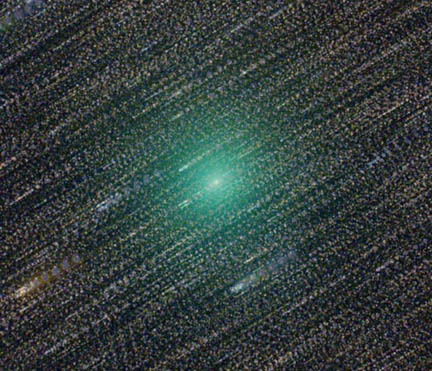
Hisayoshi Kato
While it won't be coming in for a landing, Comet 45P will miss the planet by just 7.7 million miles or about 32 times the Earth-Moon distance. Because of its proximity, we'll see this frenetic fuzzball barrel across more than 2 hours of R.A. and nearly 20° of declination in the next five days.
The comet poses no threat, but the waxing Moon might. Back in late December and January, when Comet 45P huddled nearer the sun, it quickly grew into a bright, compact ball of aqua haze with a long skinny tail, resembling an onion yanked from your garden. Now outbound from the Sun, it's quickly losing its mojo — the comet is currently tailless, large, and diffuse.
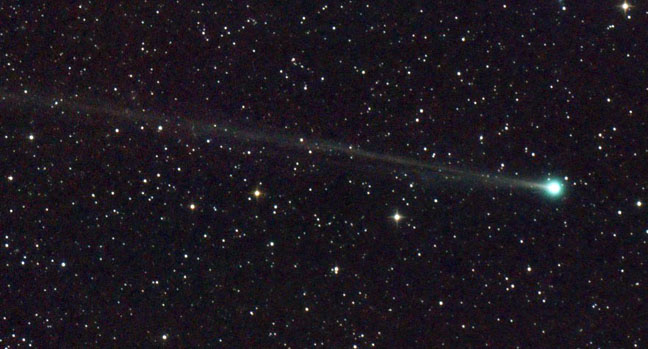
José Chambo
Astronomer Alan Hale observed it on Feb. 5th in 10x50 binoculars at magnitude 7.9 and noted a diffuse 10′ coma with a DC (degree of condensation) of 1-2. DC measures how the surface brightness of a comet increases toward the center. DC=0 indicates a totally diffuse comet; DC=9 means the coma is so concentrated that the comet appears star-like.
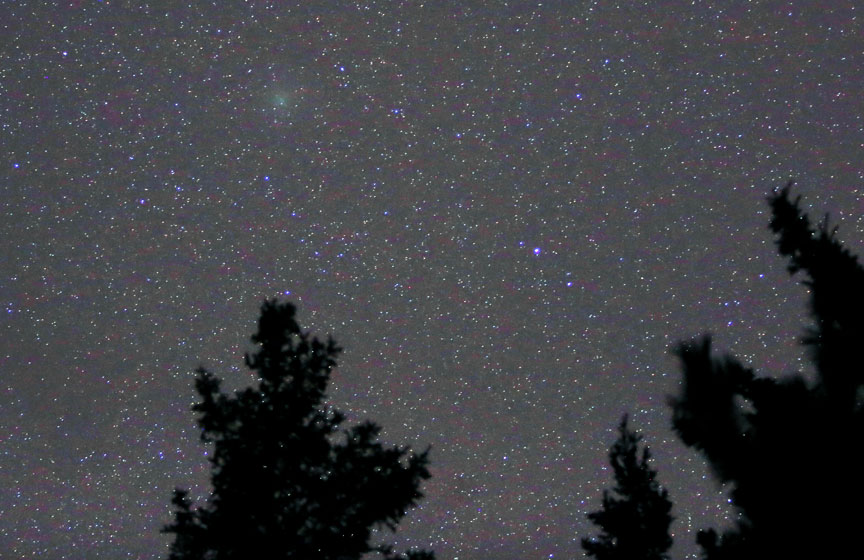
Bob King
That agrees with my own observation on that same (for me) frigid morning. Through my 10x50s, I saw a soft, faint, hazy patch of light about two-thirds the size of the full moon, or ⅓° across. It wasn’t obvious at first, but after I played my eyes around the field of view, I noticed what looked like a small puff of smoke at the comet's position in western Aquila.
Three mornings later on the February 8th, Comet 45P had climbed much higher in the sky and was even easier to see in binoculars. Larger, too. I estimated about half a degree across with DC=2. In a 10-inch telescope I noticed that a Swan Band filter helped some to improve the comet's visibility.
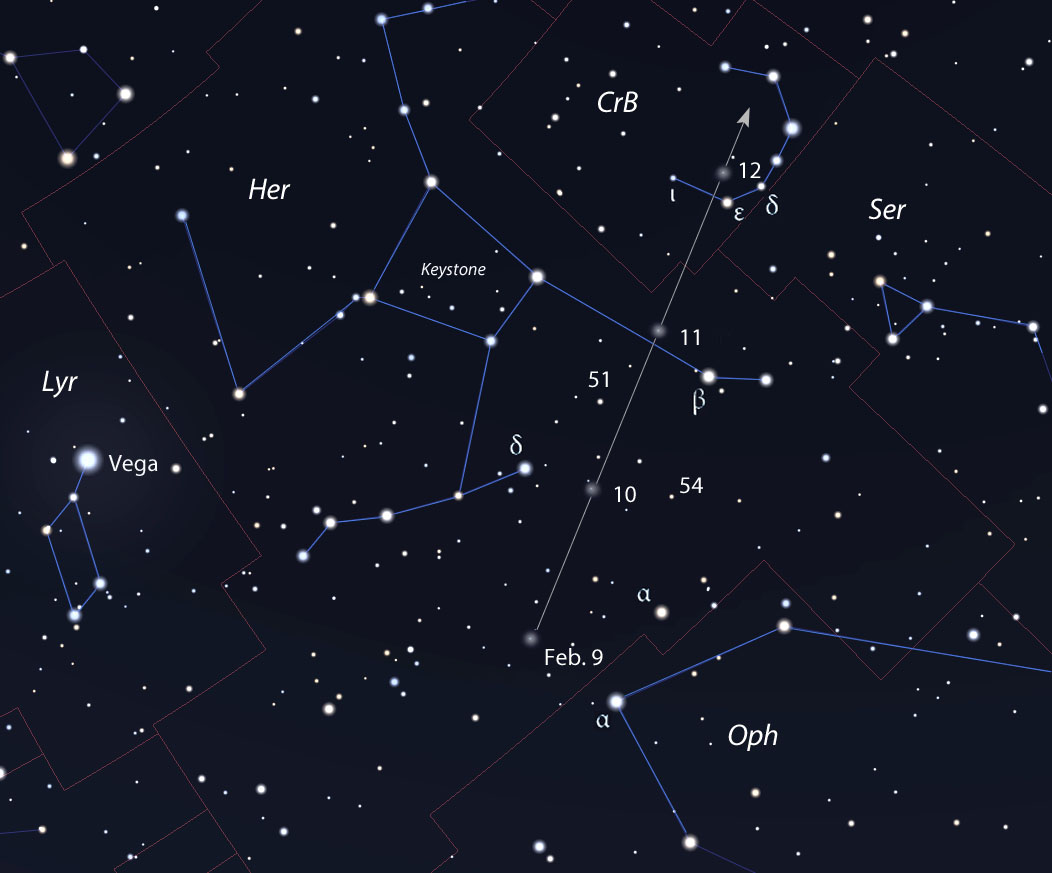
Map: Bob King, Source: Stellarium
Ah, but all these observations were made under a moonless sky. Guess who's back throwing unshielded light around with abandon? Yep! Starting Thursday (Feb. 9), the waxing gibbous Moon pushes into the morning sky and remains there as the comet whirls west and slowly fades.
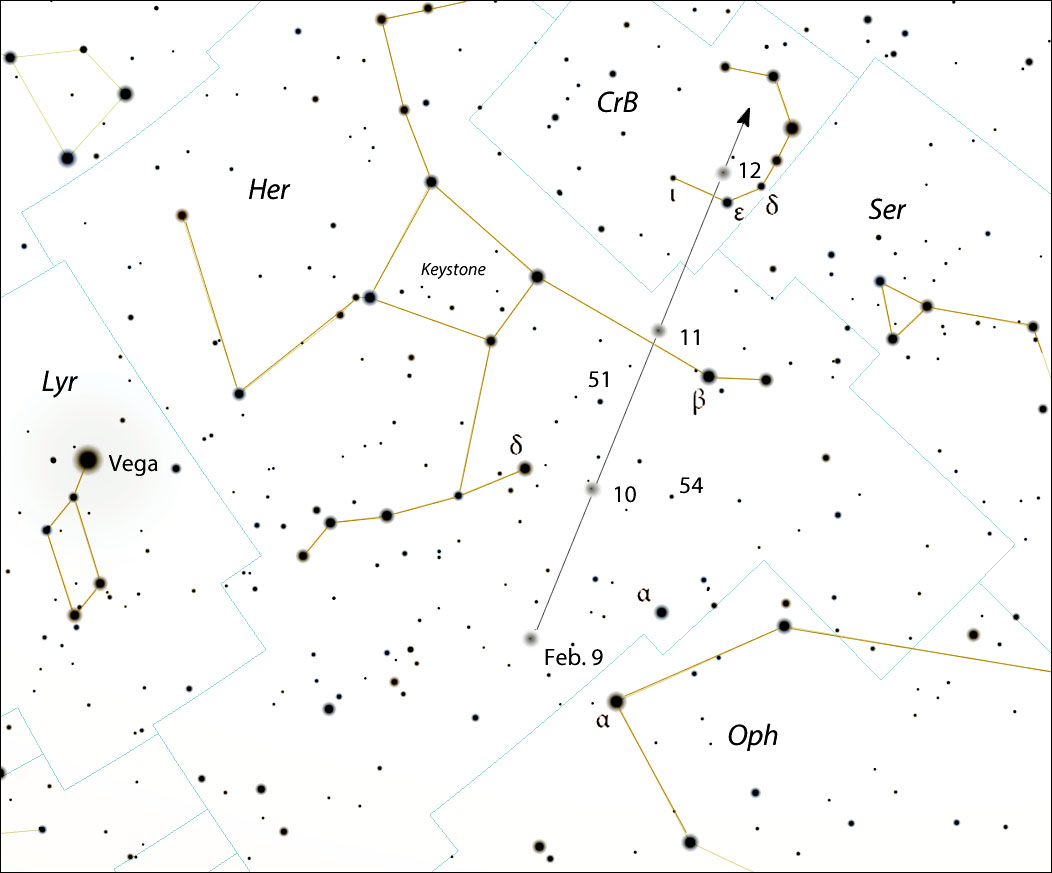
Were the Moon no factor, we’d be able to see this visitor from the Jovian realm in binoculars for at least a week or more, but moonlight will make finding Comet 45P a little trickier. Here's the good news — at least for the next few mornings, the Moon and comet will be far apart, reducing glare. Still, at magnitude 8, binocular viewing will be challenging because of the comet's diffuse appearance.
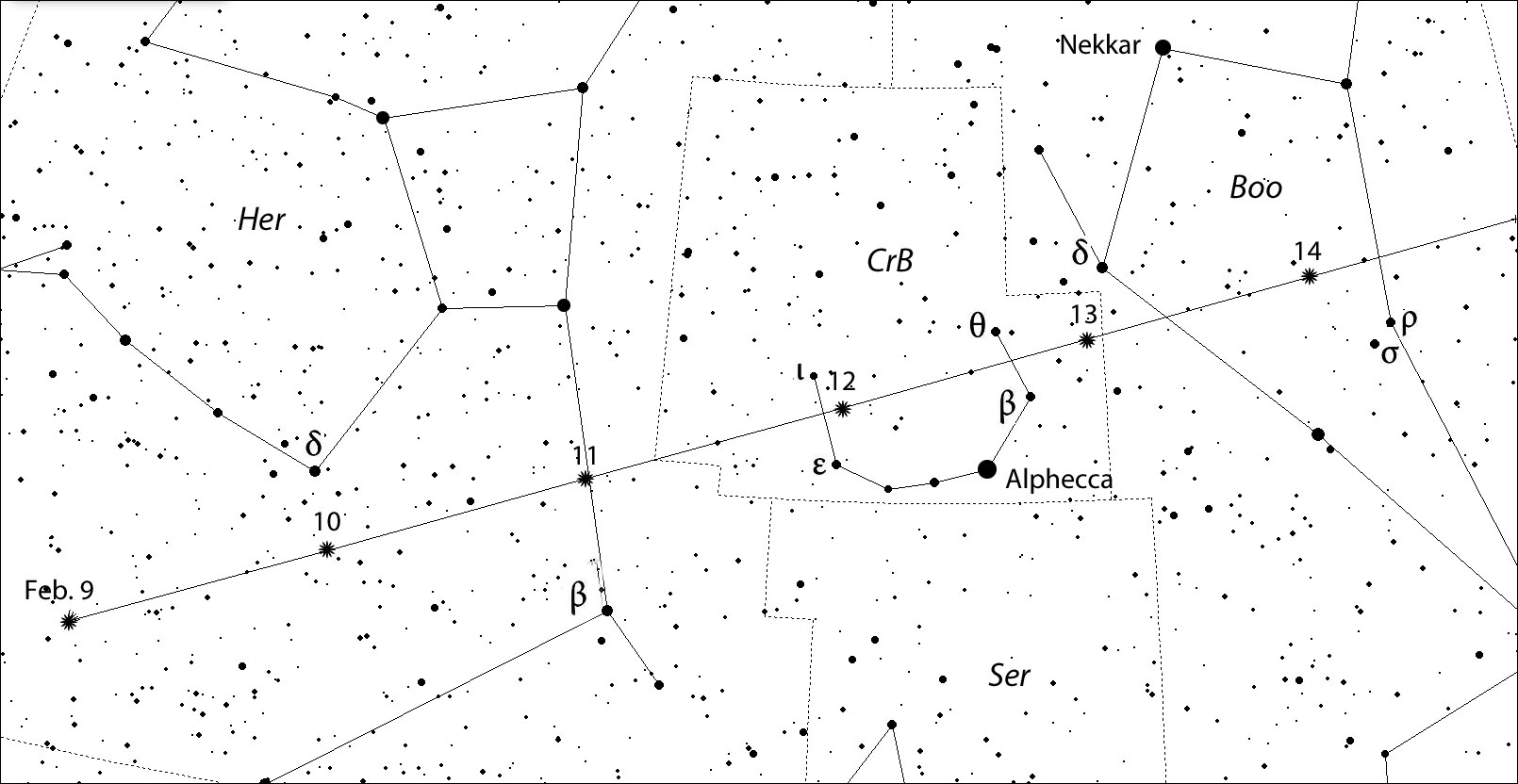
Created with Chris Marriott's SkyMap
Telescopic observers will have better luck, especially those using short focus instruments with wide fields. Stick to low magnifications in the range of 30x to 75x when seeking this bloated bag of primeval dust. Because Comet 45P's speed compares favorably with that of a bat out of hell, if you suspect seeing it through the eyepiece, wait a bit and look again. You should be able to detect movement in a matter of minutes. That's half the fun of finding and following this comet — let it take you for a ride!
Even if you do end up cursing the Moon, take heart. And I mean that literally. Come Valentine’s Day, Comet 45P will have motored into northern Bootes and appear in the east around 10 p.m. before moonrise. It will have faded to perhaps magnitude +9, but at least we'll get to see it in a dark dark sky until it fades from easy viewing later in the month.
 5
5



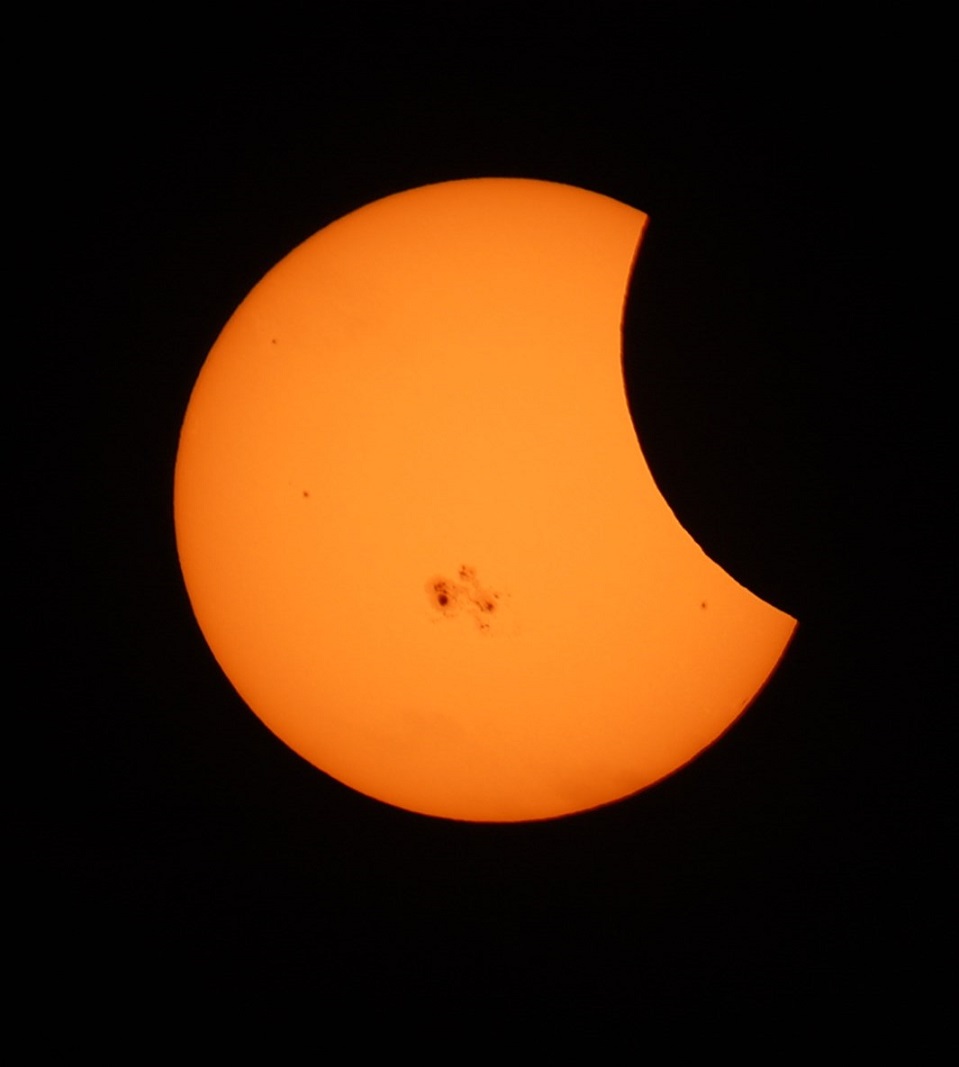





Comments
Stub Mandrel
February 11, 2017 at 5:53 am
Bob, you 'snap' is magnificent and reminds us how we can over think our astrophotography!
You must be logged in to post a comment.
Bob KingPost Author
February 11, 2017 at 2:39 pm
Thanks Stub! I salivate over some of the beautiful telescopic photos taken of comets, but I'm not set up like that. More of a grab n' go astrophotographer 😉
You must be logged in to post a comment.
Raymond
February 12, 2017 at 4:07 pm
Hi Bob,
You inspired me up to my urban rooftop this morning, to try catching 45P. The finder chart had him passing right thru Corona Borealis, so I figured might be easy to find. Alas, the gibbous moon was very bright, and Oakland light pollution didn't help either. TheSkyLive gave the current magnitude as 8.6, so being a half-degree wide would make for rather low surface brightness. I scanned the area thoroughly, could not detect the fuzzy beast. "Losing its mojo" indeed! Thanks anyway for the great article and photos.
You must be logged in to post a comment.
Bob KingPost Author
February 12, 2017 at 6:59 pm
Raymond,
You're a comet optimist! Thanks for your report and kind words. Give 45P a few days and a darker sky and you'll see in n. Bootes before moonrise in the eastern sky very soon 🙂
You must be logged in to post a comment.
Graham-Wolf
February 14, 2017 at 8:22 pm
Well done, Bob, and an excellent pic as well!
Gone on both you and Alan Hale, for being so quick off the mark.
I'm impressed!
Seiichi Yoshida observed the comet on Feb 6th UT from Japan, and myself at McMaster Road signpost near Pikiwara Summit (NZ) on Aug 08.699 UT, after several storms and days of rain, on the Taieri Plains, Otago province. We both got Mvs in the 6.7 - 6.9 range, and a DC of 2/3. I originally thought it was DC of 6/7, but encroaching dawn pollution may have created an optical -flare within my semi-coated "tired" 20mm Termi-Nagler. Used HIP Stars within 90 arcmin FOV centred on the comet for Mv estimates. Your Pic is literally identical (Wide Field), to the pale green and tail-less coma that i saw at 50X and 96 arcmin FOV down to ~ Mv 9. I also measured an oval shaped coma 20 x 16 arcmin at that same magnification.
Moon is a hassle now, but comet watchers can certainly see evening comets before the Moon rise ~ midnight or so. This morning (NZDT) the Waning Gibbous Moon was just a few hand-spans to the left of Jupiter and Saturn.
Great updated comet charts on your Blog-site, too, Bob... that should really assist your readers to get outside, and look at these "dirty snowballs" up there!
Keep up the great work.
Regards from 46 South, NZ.
Graham W. Wolf.
You must be logged in to post a comment.
You must be logged in to post a comment.